| Main Page - Back |
|
From SudokuWiki.org, the puzzle solver's site |

Innies and Outies
This is a fundamental strategy for Killer Sudoku puzzles of any difficulty. It is extremely versatile and worth looking out for it at every stage. Fortunately it only requires simple addition and spotting a certain type of pattern.
Since the basis of the puzzle is Sudoku, each row, column and box will eventually have solutions which always add up to 45. If we can identify a group of cages which almost covers a unit (or more than one unit) but has one cage either sticking out (an Outie) or poking in (an Innie) we can make some very useful deductions.
I'm going to refer to Block as any set of adjacent rows, columns and boxes we can use in concert, but also a block could be just one row, column or box. Innies and Outies occur naturally because cages often line up with the Sudoku elements but in the middle and end game you can split the cages that contain solutions and create new useful blocks that were not available at the start.
I've deliberately split this strategy in the solver between the easier-to-spot single cell Innies and Outies and the multiple cell ones - which require more mental calculation and therefore go further down the strategy order. Lets plunge in.
You will see two examples in the first diagram. This Killer Sudoku is symmetrical - which will often yield a double Innie and Outie.
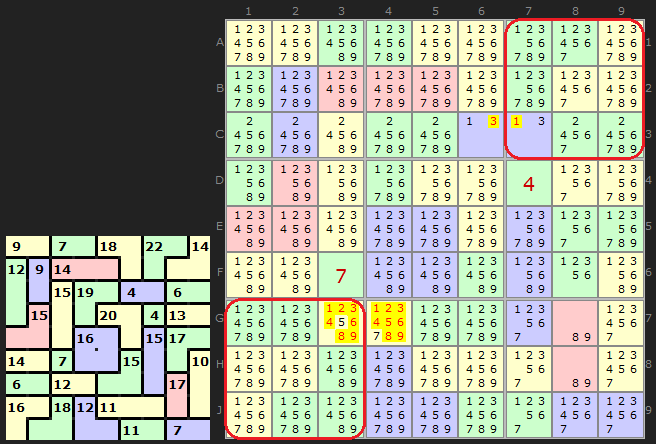
The two red rings surround boxes 3 and 7. Both boxes contain complete cages apart from one two cell cage. Lets add up the clues for complete cages in each box. We have:
Box 3 = 22 + 14 + 6 = 42
Box 7 = 6 + 16 + 18 =40
We therefore know that Box 3 is missing 3 which can only go in C7 and Box 7 is missing 5 which must go in G3. Because we are dealing with simple 2-cell cages we get the other halves as well.
Since the basis of the puzzle is Sudoku, each row, column and box will eventually have solutions which always add up to 45. If we can identify a group of cages which almost covers a unit (or more than one unit) but has one cage either sticking out (an Outie) or poking in (an Innie) we can make some very useful deductions.
I'm going to refer to Block as any set of adjacent rows, columns and boxes we can use in concert, but also a block could be just one row, column or box. Innies and Outies occur naturally because cages often line up with the Sudoku elements but in the middle and end game you can split the cages that contain solutions and create new useful blocks that were not available at the start.
Single Cell Innies and Outies
I've deliberately split this strategy in the solver between the easier-to-spot single cell Innies and Outies and the multiple cell ones - which require more mental calculation and therefore go further down the strategy order. Lets plunge in.
You will see two examples in the first diagram. This Killer Sudoku is symmetrical - which will often yield a double Innie and Outie.

The two red rings surround boxes 3 and 7. Both boxes contain complete cages apart from one two cell cage. Lets add up the clues for complete cages in each box. We have:
Box 3 = 22 + 14 + 6 = 42
Box 7 = 6 + 16 + 18 =40
We therefore know that Box 3 is missing 3 which can only go in C7 and Box 7 is missing 5 which must go in G3. Because we are dealing with simple 2-cell cages we get the other halves as well.
If we proceed a little further down the puzzle we get another useful Innie and Outie, this time made up of two columns. Since we are using two columns, the number we are interested in arriving at is 90. On the left hand side ringed in red, the cages are 9 + 12 + 9 + 15 + 14 + 6 + 16 = 81, so 9 has to come from the 3-cell cage totalling 18. 9 can be placed in J2. As the puzzle is symmetrical a similar technique can be applied to the other side.
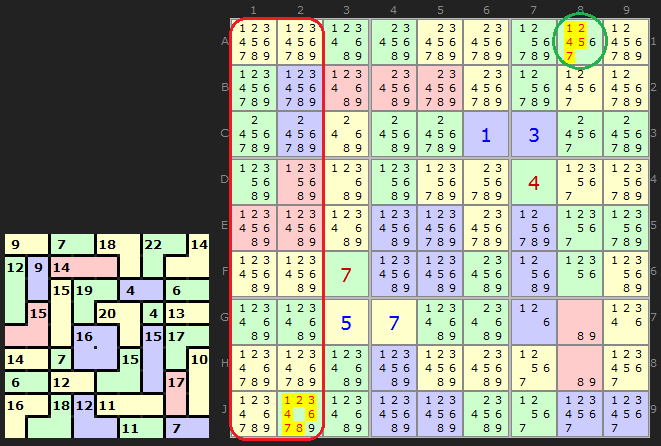
I'm grateful to Deelight in France for this example. This shows a group of four boxes and an Outie in C3. The total of four boxes is 180 and if we add up all the cages including the cage starting in C3 we get 181, so 1 must exist outside the four boxes. As C3 is the only outie cell that's where 1 must go. Note that we are able to consider these four boxes as a block with a single Outie cell becuase we solved the cell in G7. We can take the cell clue (12) and take off 2. That's how we get to 181.
[As of 9th Dec 2014] the solver can complete this Killer. You can Load it here and see the example.
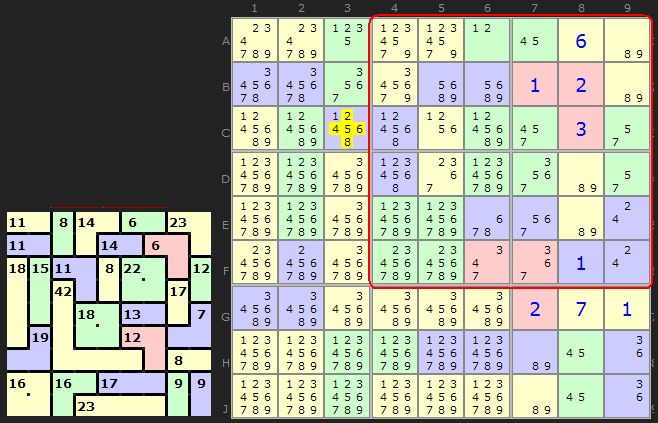
1 Innie + 1 Outie
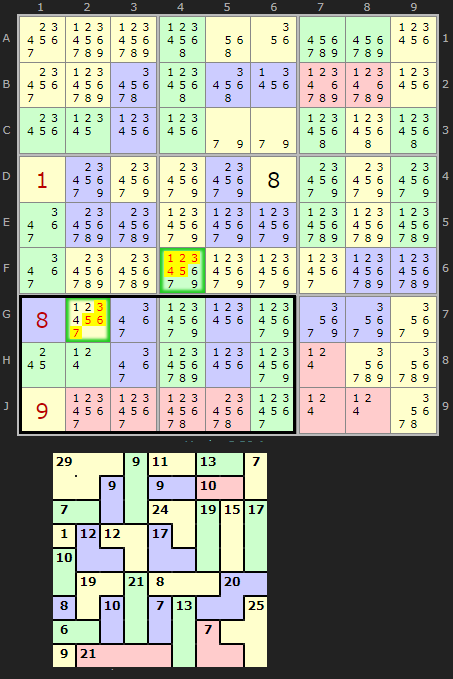
For this documentation page I've picked a relatively easy puzzle with eleven instances so well worth stepping-though on the solver. You can load it from here.
This block of two boxes must add up to 90 (45+45). The pattern we want is one innie cell, in this case G2 and one outie cell, here F4. The remaining cells of the outie cage are inside the block. The remaining cells of the innie cage are outside. We are going to add up all the cages entirely inside the block (which is 74) and then add the cage with the one cell outie F4. So 74+21 gives us 95. There is a difference of 5 (95 - 90). That means the solution for G2 must be 5 less than the solution for F4. This clears a lot of clutter since three pairs exist: 1 and 6, 2 and 7 and 4 and 9. Other candidates can be removed. The solver will return:
INNIE/OUTIE: A BLOCKS of 2 boxes (6 and 7)...
that contains a 1-cell innie G2 and a 1-cell outie
F4 must have solutions which differ by 5. (95-90=5). Therefore:
- we can remove 3/5/6/7 from G2
- we can remove 1/2/3/4/5 from F4
The Pseudo-Cage - multi-cell Innies
There is no restriction on the size of Innies and Outies - merely what is useful, and this goes back to combinations that fit certain cage sizes and have certain clues. Some cages are plane unhelpful, for example 24 spread over 4 cells. There are eight possible combinations from 1/6/8/9 to 4/5/7/8. 24 over 3 cells is much more interesting: 7/8/9 can be the only fit. So how about looking for Innies that are two, three - maybe four cells that have very low clues values or very high clue values.
The great idea about multi-cell Innies and Outies is that they don't have to fall over the existing cages the puzzle designer has made. You are creating new cages to restrict the candidates in the same way, but are made up on the spot from rows, columns and boxes - entities you know much add up to multiples of 45. I like to think of these are virtual or pseudo-cages - fleeting but useful.
Take this Killer Sudoku and the situation in box 6. Four cages are entirely inside the box and these have clues 8, 13, 14 and 5 which add up to 40. The remaining two cells in D7 and E7 therefore must add up to 5, to make a total of 45. It doesn't matter that these two cells are not in the same cage. D7 and E7 form a pseudo-cage of size 2 and a 'clue' of 5. That could be 1/4 or 2/3. Either way, we can remove 6/7/8/9 from those cells. It gets us closer.

The great idea about multi-cell Innies and Outies is that they don't have to fall over the existing cages the puzzle designer has made. You are creating new cages to restrict the candidates in the same way, but are made up on the spot from rows, columns and boxes - entities you know much add up to multiples of 45. I like to think of these are virtual or pseudo-cages - fleeting but useful.
Take this Killer Sudoku and the situation in box 6. Four cages are entirely inside the box and these have clues 8, 13, 14 and 5 which add up to 40. The remaining two cells in D7 and E7 therefore must add up to 5, to make a total of 45. It doesn't matter that these two cells are not in the same cage. D7 and E7 form a pseudo-cage of size 2 and a 'clue' of 5. That could be 1/4 or 2/3. Either way, we can remove 6/7/8/9 from those cells. It gets us closer.

Using Locked Sets to Split Cages
Here is a bolder four cell pseudo-cage using the top row as the block. We have one cages entirely inside the row (11) plus 1 and 3 (solutions in A3 and A5) gives 15. So 30 must be spread over four cells. 15+30=45. 30 is a good number since only 6/7/8/9 adds up to 30 so all the numbers below 6 can be removed. That gives us a solution of 8 in A4.
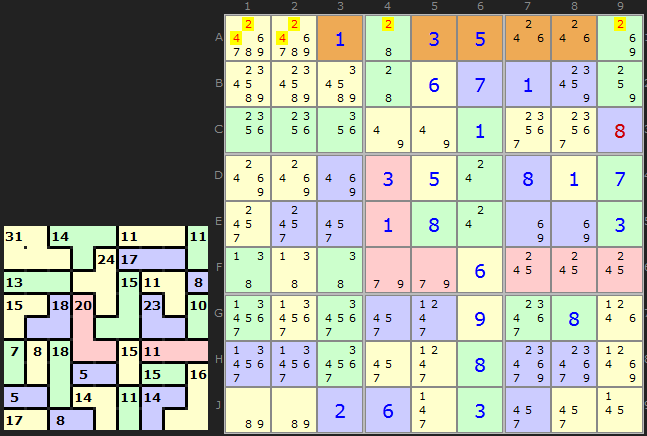
Just to show truly large 'blocks' can be useful, here is an example of four rows in combination. Looking at the design of the puzzle you can see so many cages conveniently lined up it's begging for some Innie/Outie identification. At this point the top four rows must add up to 180 and two cages stick out. The two cells inside the block must add up to 8 since the total of all those cages is 172. As the two cells are in the same row 4 and 4 is out. So to is 8 and 9 and we can remove those candidates. This is a fun example to step through.
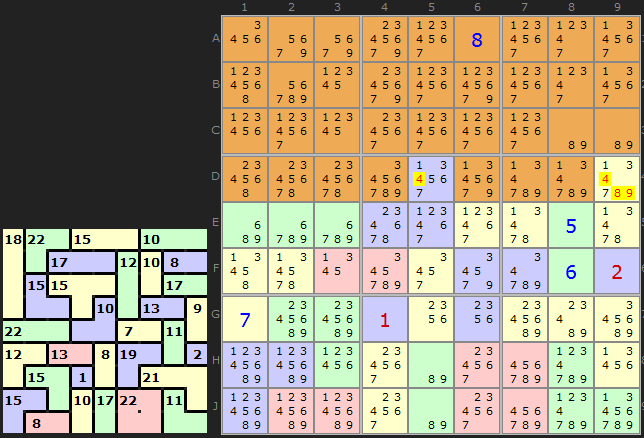
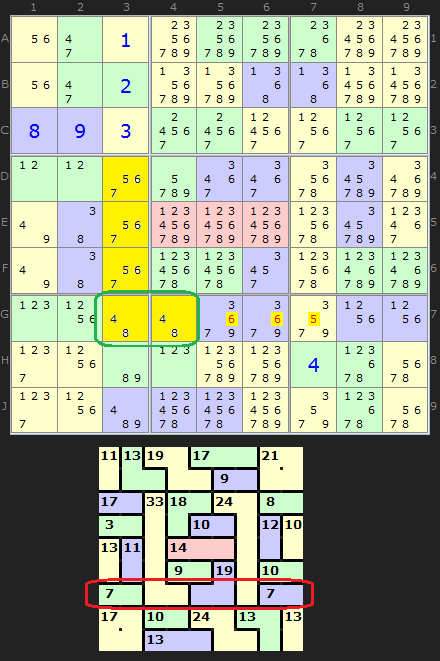
I was considering a puzzle idea sent to me by J Ignacio Fernandez from Spain when his idea kicked off another idea in my head. We were both looking at row G in the next puzzle. I got the notion that we could used Locked Sets to expand the number of Innies and Outies eliminations.
In the puzzle sent to me we have a long 5-cell cage valued at 33. The bottom two cells G3 and G4 contains a Naked Pair - a simple locked set. Because we know 4 and 8 must go in those cells (just not which way round yet) we can sum those values and let them contribute to the block we are making.
So adding 7 and 7 (first and last cages in row G) to the 12 (4+8) from G3 and G4 we get 26. So we need 19 to fit in the last three cells G567. Combinations of 19 in three cells means we can remove a candidate in each as shown on the diagram.
If the solver makes use of Locked Sets it will report this info alert:
(*note: the cage that includes C3 has been split to include it in the block)
New in version 2.12 (October 23th 2023)
Important update thanks to JohnNoneDoe from Arizona who supplies many examples in the comments, I have improved the Innies and Outies strategy. Particularly outies which he observed, do not need to obey the Dog-leg restriction on the pseudo-cell they create. This improvement has a large effect on hard Killers improving the hit rate (I hope). I have also changed how a block displays so as not to override the cell colours.
Important update thanks to JohnNoneDoe from Arizona who supplies many examples in the comments, I have improved the Innies and Outies strategy. Particularly outies which he observed, do not need to obey the Dog-leg restriction on the pseudo-cell they create. This improvement has a large effect on hard Killers improving the hit rate (I hope). I have also changed how a block displays so as not to override the cell colours.